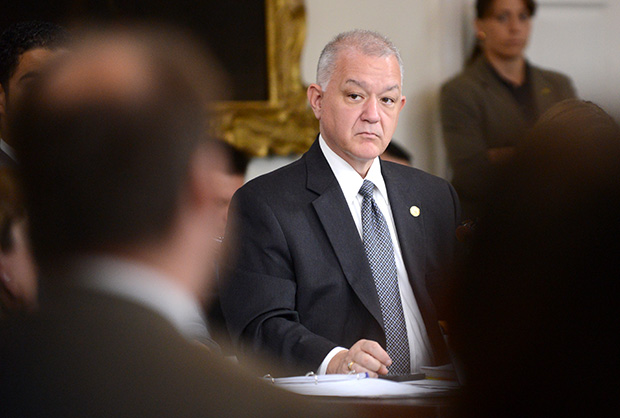
Former Budget Secretary David Brinkley said that, while lawmakers may not propose a change to the Blueprint during the legislative session that begins in January, he expects them to in the coming years. (File photo)
As Moore avoids specifics on deficit in state budget, conservatives warn of tax hikes
Originally published in the Daily Record
Gov. Wes Moore and members of his Cabinet have shied from specifying how spending may change as the state approaches a projected structural deficit after years of surplus.
The Moore administration and its allies in the state legislature have said that — roughly five months from when the governor is expected to introduce his proposed budget — it’s too early to outline a specific approach for balancing the budget.
Cabinet members have said that “discipline” and “focus” will guide the administration’s decisions as it seeks to expand the state’s tax base and reckon with years of lackluster economic growth.
Conservatives, meanwhile, are concerned the state will raise taxes and place more onus on counties to pay for a plan to transform public education systems and increase annual school funding by $3.8 billion over 10 years.
Lawmakers entered the last legislative session with a multibillion-dollar surplus — thanks, in part, to years of federal COVID relief and historic stock market performances.
But Maryland, a state with a $63 billion budget this year, is now projected to have a $418 million deficit for the fiscal year that begins July 1, 2024, according to the Department of Legislative Services.
The deficit is projected to reach $1.8 billion by 2027, in large part because of the costs of the Blueprint for Maryland’s Future education plan.
David Brinkley, a former Republican state senator and the secretary of budget and management under former Republican Gov. Larry Hogan, said he wouldn’t be surprised to see lawmakers grant counties more authority to tax income, sparing the legislature from raising state taxes to pay for the plan.
Brinkley — who helped recalculate how the state would disburse revenue to school systems but who also opposed the Blueprint — said that counties are worried the state may offer more funding for the Blueprint to jurisdictions willing to generate matching revenue by raising taxes.
“That would be extremely detrimental to Maryland,” Brinkley said, arguing that higher local tax rates would be “hostile” to people looking to live and work in the state. “To pass it on to the counties is just wrong.”
Christopher Summers, president and CEO of the conservative Maryland Public Policy Institute, shared Brinkley’s concern about raising taxes to pay for the Blueprint.
“By not deigning to address the expensive mammoth in the room, the governor is leading us all to the only other option available to government: tax hikes,” Summers said in a statement.
He argued that higher taxes are going to drive more people and businesses out of a state that had a declining population last year.
Brinkley said that, while lawmakers may not propose a change to the Blueprint during the legislative session that begins in January, he expects them to in the coming years.
He said that lawmakers may opt to extend the timeline for implementing the Blueprint, lower the projected cost of the project or change people’s expectations for it.
Democratic officials, including the governor and members of his Cabinet, have said repeatedly that the projected deficits aren’t new for Maryland.
Lawmakers have had to make cuts to balance the state’s budget in 17 of the last 20 years, and the state has forecasted structural budget deficits since at least 2017, Moore said during a recent speech.
Moore and members of his Cabinet have declined to say whether the administration will propose new taxes, saying it’s too early in the budget cycle.
Cabinet members have said the administration will focus on the state’s long-term interests, which will necessitate “choices and trade-offs” to expand an economy they say hasn’t kept pace with a growing budget.
It’s too early to tell whether Moore’s agenda will have to be reeled in, said Sen. Guy Guzzone, a Democrat and chair of the Senate Budget and Taxation Committee.
The state comptroller is expected to release new revenue estimates on Sept. 28. The state will also have more up-to-date numbers leading up to the legislative session and another forecast during the session.
“We’re gonna see where we are when the next revenue estimates come out,” Guzzone said, adding that there’s no question the state will have less revenue than in recent years.
He also downplayed the Maryland Public Policy Institute’s concerns about tax hikes.
“That’s what they always warn about,” he said.
The projected deficit may require that lawmakers cut funding from some government programs that aren’t as effective as others, Guzzone said. Moore’s ambitious agenda “adds to the calculation,” he said.
The Moore administration has been examining agency budgets to gauge what needs to change and where costs can be saved, among other considerations, Guzzone said. It’s a typical self assessment for the early part of a four-year term.
When asked about its reviews of agency and departmental budgets, the governor’s office issued a generic statement about the themes of Moore’s approach.
“The governor is focusing on this year’s budget with three main principles in mind: Taking a balanced approach, using data to inform strategy, and prioritizing spending in a way that harnesses our assets — which will prepare Maryland to dominate industries of the present and lead innovative industries of the future,” spokesman Carter Elliott IV said in a statement.





